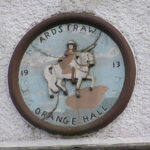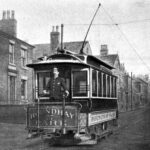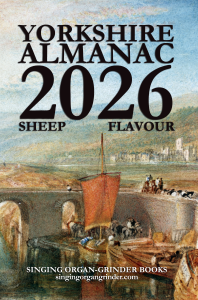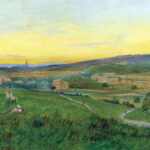24 October 1877: Six years after the inauguration of its horse trams, the Leeds Tramways Company tests a steam car by Kitson and Co. of Hunslet
Leeds Mercury. 1877/10/25. Trial of a Steam Tramway Car in Leeds. Leeds. Get it:
.Excerpt
The car is of less dimensions than those ordinarily running in our thoroughfares, and contains the boiler and machinery, besides giving ample room for those in charge of it. It is, in fact, a little engine house on wheels. The gearing, however, is not visible, and two important disadvantages in the working have evidently been overcome, namely, that the working shall be noiseless and that there shall be no escape of smoke or steam: coke is burned, and on the top of the car there are steam condensers. The car is capable of drawing two, or even three, of the ordinary tramway cars loaded, on a level line, and if it were necessary, could travel at a much higher rate of speed than is possible with horses. Private trials of this car have already taken place in Leeds at an hour when there was little or no other traffic. Yesterday, however, the car was run over the line between Hunslet and Kirkstall in the forenoon, at a time when the traffic is probably at its heaviest. As a rule, horses passed the car without showing the slightest signs of fear, but a few proved somewhat troublesome. It may be said, however, that the experiment on the whole was very successful, almost the only drawback being the emission of sulphurous fumes and grit from the funnel. Wellington Street, Boar Lane and Briggate were lined with crowds of people waiting to see it pass.
Comment
Comment
This trial followed a long period of more or less successful implementations by other builders elsewhere: the article says that “For some time steam cars similar to this have been used on street tramway lines in Russia and in Germany” (really?), while Daniel Kinnear Clark cites schemes starting in 1859 in the United States, and says that Leonard J. Todd of Leith appears in 1871 to have been the first to build a relatively steam-, smoke-, and noise-free car, like the Kitsons’ (Clark 1894). DKC shows a late 1880s Kitson engine, but doesn’t mention this experiment or its somewhat mixed sequel:
Regular steam car services were not operated, however, until two years later, and then only on routes then being operated by horse cars. Steam trams were not very successful as the heavy engines caused much damage to the very light rails and so were replaced by horse trams again on several routes (Garside 1981).
Re “could travel at a much higher rate of speed than is possible with horses”: speeds were kept low by regulation and/or legislation (Leeds Mercury 1877/03/08).
Something to say? Get in touch
Original
TRIAL OF A STEAM TRAMWAY CAR IN LEEDS. A trial of a steam tramway car, the invention of Messrs. Kitson and Co., took place yesterday, over the Leeds Tramway Company’s line from Hunslet to Kirkstall. For some time steam cars similar to this have been used on street tramway lines in Russia and in Germany. The car is of less dimensions than those ordinarily running in our thoroughfares, and contains the boiler and machinery, besides giving ample room for those in charge of it. It is, in fact, a little engine-house on wheels. The gearing, however, is not visible, and two important disadvantages in the working have evidently been overcome, namely, that the working shall be noiseless and that there shall be no escape of smoke or steam. To prevent the escape of smoke coke is burned, and on the top of the car there are steam condensers, and at the trial yesterday there was neither smoke nor steam visible. The car is capable of drawing two, or even three, of the ordinary tramway cars loaded, on a level line, and if it were necessary, could travel at a much higher rate of speed than is possible with horses. What may be called private trials of this car have already taken place in Leeds, at an hour when there was little or no other traffic in the streets. Yesterday, however, the car was run over the line between Hunslet and Kirkstall in the forenoon, at a time when the traffic is probably at its heaviest. This was a good test of whether it is at all practicable to adopt a steam car in a thoroughfare, such as Wellington-street, for example, where horses are constantly passing and repassing. As a rule, horses passed the car without showing the slightest signs of fear, but a few were met with who proved somewhat troublesome. It may be said, however, that the experiment on the whole was very successful, almost the only drawback, which it is said can be remedied, being the emission to some extent of sulphurious fumes and grit from the funnel. The greatest interest was taken in the new invention by the public, for Wellington-street, Boar-lane, and Briggate were lined with crowds of people waiting to see it pass.
381 words.
Similar
 23 January 1643: Thomas Fairfax, the Rider of the White Horse, captures Leeds from the Beast with the help of Psalm 68
23 January 1643: Thomas Fairfax, the Rider of the White Horse, captures Leeds from the Beast with the help of Psalm 68 14 December 1892: Experts tell the High Court that electromagnetic interference from Leeds’s 1891 overhead electric tramway to Roundhay – the nation’s first – has brought down the local telephone service
14 December 1892: Experts tell the High Court that electromagnetic interference from Leeds’s 1891 overhead electric tramway to Roundhay – the nation’s first – has brought down the local telephone serviceSearch
Donate
Music & books
Place-People-Play: Childcare (and the Kazookestra) on the Headingley/Weetwood borders next to Meanwood Park.
Music from and about Yorkshire by Leeds's Singing Organ-Grinder.



 Bluesky
Bluesky Extwitter
Extwitter